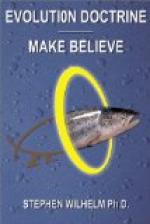Each one of these tribes by itself provides conclusive evidence of evolution, for it is most reasonable to regard the “theme” in every case as a product of common inheritance, while the variations of any theme are best understood as the results of adaptive changes in various directions. But the examples have disclosed a larger relation and a principle of wider scope, as indeed the assignment of all these tribes to the single natural group of the carnivora implies. These tribes are put together because comparative anatomy finds that the common characters of all cats are fundamentally like those of all dogs and bears and seals, and in these common qualities the carnivora differ from all other mammalia. Does this mean that the branches which bear respectively the various members of the several tribes are outgrowths of a single limb of the evolving animal tree? Science does not hesitate to give an affirmative answer, because, as in the case of the similar but varying domestic cats, no other explanation of tribal resemblance in structure seems so reasonable and natural.
So far the examples have been taken from one order of the highest class of backboned animals, called mammalia. When our survey is extended to other divisions of this class, additional laws of organic relationship are discovered. If in a series of evolving generations the line of modification proceeding from a terrestrial animal like a cat to semi-aquatic and marine types substantially like an otter and a seal should be carried further, it will inevitably lead to forms possessing characters such as those displayed by whales and the related porpoises, dolphins, and narwhals of the order cetacea. In their make-up all of these animals clearly possess the general characteristics of mammals, and they constitute collectively another limb which has sprung from the same stock as the carnivora, although at an earlier time. This we believe because of their plan of body and because their peculiar organization fits them even more perfectly than the seals for aquatic existence that is their only possible mode of life. In the case of the whales the bony framework of the fore limb is again like that of the cat’s leg, although the whole structure is a flexible finlike paddle. The hind limb has disappeared as an efficient




